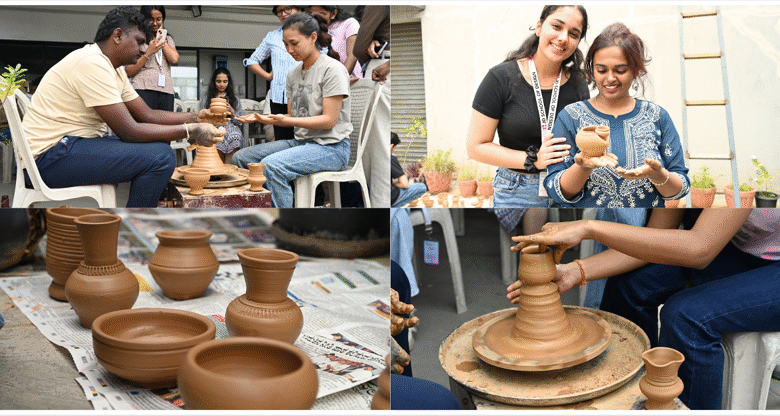Shaping Ideas with Clay: Pottery Workshop for the JD School of Design Students

In a world where design begins so many times on a screen, it is possible to lose sight of the pleasure of doing things by hand. But occasionally, some of the most valuable lessons are not from software or drawing, but from rolling up your sleeves and watching a material come alive in your hands. That is precisely what occurred at the Pottery Workshop, which was conducted as a part of the 2D and 3D Graphics module for the B.Sc. Interior Design and Decoration 2025 batch at JD School of Design.
At the helm of these skilled craftsmen, who brought with them years of craft expertise, the session asked students to experience the art of pottery. A workshop in more than name, it evolved into a journey of creativity—one that brought together tradition and design education and reminded everyone of the importance of patience, texture, and form.
On the surface, pottery could be easy: take a clump of clay, shape it, and heat it up into something practical or something pretty. But as the students soon learned, clay is a diva. It resists, it gives in, it requires attention—and in exchange, it educates.
The instructors started off with the fundamentals: the varieties of clay, how to condition it, and the use of water to soften it. Students observed intently as demonstrations revealed how the most basic gestures—pressing, pinching, coiling, and throwing—could give life to the medium. The lab, normally cluttered with design models and sketches, became an area humming with quiet focus and guffaws as everyone got their first taste at the wheel.
Clay, unlike an electronic aid, provides immediate feedback. Too much pressure, and it breaks. Too little, and it won’t shape. This delicate balance between control and letting go reflected what many students had learned along the way in their design process: creativity is as much about patience as it is about vision.
It was one of the goals of this workshop to assist students in bringing conceptual thoughts into reality. Pottery, with its immediate and hands-on process, was just the medium.
As they shaped, moulded, and re-moulded the clay, students felt the miracle of raw material turning into meaningful form. Some made simple bowls, others worked on abstract shapes, and some even attempted to replicate patterns from architectural sources. Every piece was flawed, but intensely personal—a reflection of the creator’s thinking process and exploration.
This experiential exercise enriched more than technical proficiency. It fostered visualisation and spatial intelligence, skills interior designers must have. Through actual construction of shapes, students were able to more fully comprehend volume, proportion, and texture—abstract concepts they so frequently deal with in digital or theoretical terms.
What made the workshop particularly significant was the way it bridged traditional craft and modern design education. In today’s fast-paced world, design students often lean heavily on technology to visualise and present their ideas. While these tools are powerful, they can sometimes distance the designer from the essence of making.
The pottery class was a reminder that hand skills are still at the centre of design. Squeezing clay between their fingers, working it by hand, and coping with its capriciousness provided students with an appreciation for craftsmanship and materiality that no computer program can ever provide.
The students also discussed the cultural tradition of pottery in India, where clay has been a storytelling tool, a source of functionality, and an object of beauty for centuries. By working with this long tradition, students were learning a skill but also tapping into a richer making tradition.
At the conclusion of class, the students arranged their work—a set of bowls, vases, small sculptures, and experimental shapes. Some were crude, some unexpectedly elegant, but all wore the badge of creation.
The lessons they gleaned went beyond pottery. They discovered that design is not just about sleek presentations; it’s also about the dirty, chaotic, and satisfying process of creating. Clay instilled patience in them, as shapes fell apart and had to be reassembled. It instilled creativity, as errors became new directions for designs. And most of all, it instilled an appreciation for the hands-on, physical nature of design—an experience that will remain with them long after the clay has dried.
As they continue on in their education and careers, the experience of this workshop will probably remind them that all great design—a home, a room, or even a piece of furniture—starts with a personal knowledge of form, texture, and materiality. And sometimes it just takes a ball of clay to flesh out that knowledge.




